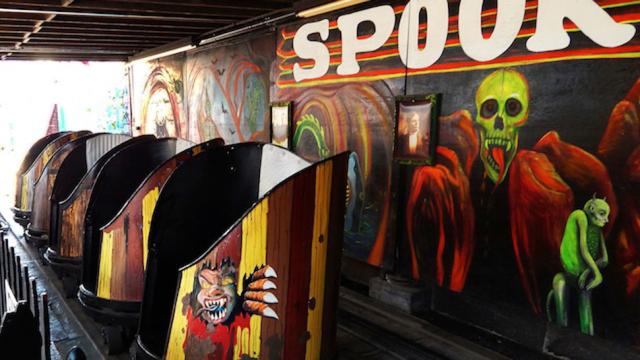Most roller coasters put their stomach-dropping slopes and brain-twisting loops front and centre for all the world to see. But the amusement-park attractions known as “dark rides” keep their thrills hidden.
When it comes to roller coasters, you know exactly what you’re getting into; it’s all right there in the open. But when it comes to dark rides — those slow moving train cars shrouded in darkness and fright — it’s what you don’t know that’s so appealing. Lisa Hix of Collectors Weekly talked to a dark ride connoisseur to get to the bottom of what makes these thrills tick.
As you’re standing in line for a tour of a haunted house full of ghosts and ghouls, a high-seas adventure with pirates, or a ride on the range with gun-slinging cowboys of the Wild West, all you can see are the riders in front of you, who get into little cars before disappearing through swinging doors into the dark. You hear the sounds of screams and shrieks coming from within. And then, an empty car arrives, stopping before you with a mechanical ka-thunk. You’re next.
Dark rides with names like Pretzel, Laff in the Dark, Whacky Shack, or Spook-A-Rama popped up everywhere in the mid 20th century. Growing up in East Providence, Rhode Island, in the ’60s, George LaCross was lucky enough to ride dozen of ’em. As an adult, LaCross realised his beloved attractions were starting to disappear. In 1999, he teamed up with Bill Luca to create Laff in the Dark, the first website dedicated to dark rides and walk-through funhouses, and the pair began to thoroughly chronicle the history of these attractions around the United States, inside and out.
LaCross and Luca also produced two documentaries about operating 1970s-era Pennsylvania dark rides, “Behind the Scenes at Knoebels Haunted House” and “Behind the Scenes at Waldameer’s Whacky Shack & Pirate’s Cove,” both available on DVD. We talked to LaCross about where dark rides came from, why they’re so irresistible, and why so many have disappeared.
Collectors Weekly: How did dark rides get started?
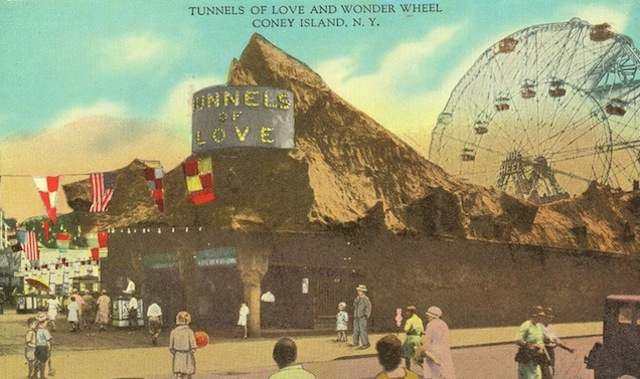
A vintage souvenir postcard advertises the Wonder Wheel and an “old mill” ride named tunnels of Love in Coney Island, New York. (via Ephemeral New York)
George LaCross: The forerunner to a single-rail dark ride was an “old mill,” a boat ride that went through a tunnel. When the old mills started cropping up around 1900, they were the first type of ride where you’d sit in a vehicle — a boat passing along a narrow channel — and see scenes or figures, called “stunts” in the industry. Some parks wanted these rides to be scary; others wanted them to be a trip through history, or a cruise around the world, that type of thing. These used mannequins — I think they were made out of wax, actually — to show the signing of the Declaration of Independence or Columbus landing on American soil. Some had dark areas for smooching, which is which why they got the nickname, “Tunnels of Love.”
Old-mill rides were very expensive because you had to have a tunnel with some type of a canal system, and then a wooden water wheel continuously spinning to push the water through it. And they were difficult to maintain. You had to constantly look for leaks in the wooden canal and patch them up during the off-season. I can’t even imagine what a nightmare it must’ve been re-boarding that stuff. Now, the ones that are still around have been converted to concrete canals, which are treated with special chemicals so they don’t leak. Back in the day, only the parks that were doing really well could afford to have old mills.
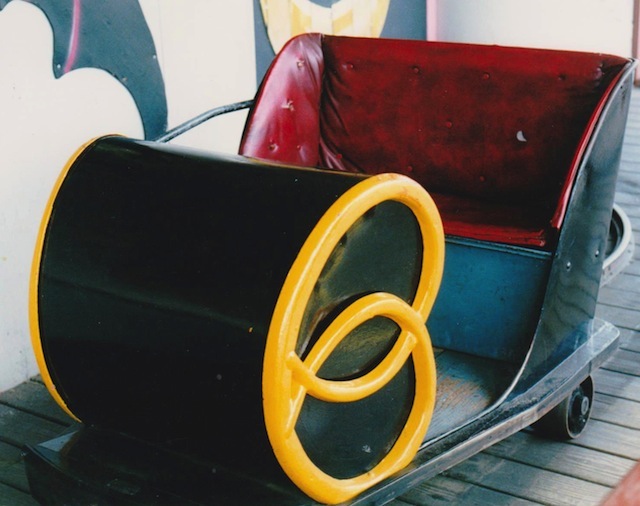
This original 1954 Pretzel metal car with the logo on both sides is still operating in the Laffland ride at Sylvan Beach Amusement Park in upstate New York. (Courtesy of LaffintheDark.com)
In the late 1920s, Tumbling Dam Amusement Park in Bridgeton, New Jersey, was struggling. The two owners, Leon Cassidy and Marvin Rempfer, desperately wanted to add some type of a dark attraction. And they were considering an old mill, but that was cost-prohibitive for them. Cassidy and Rempfer decided to build something on their own that wouldn’t involve the cost of putting in a wooden tunnel, something that used electricity.
So they took a “dodgem” car, also known as a bumper car — probably right off of their fleet — and modified the bottom of it to fit on a single-rail track. Then they ran this track through an older building that wasn’t being used. After a little tweaking, they got the dodgem to go around curves and so forth. I’m not sure exactly what they put in there, whatever they could come up with at the time, but they ended up with the very first dark ride, which they opened in 1928.
They ran a contest to name it, and the little girl who won called it Firefly, but they decided that might imply a fire danger, because they had electricity running through a wooden building. One of the first patrons came out of the dark ride, which had a lot of curves in it, and said, “Wow, I felt like I was twisted around like a pretzel.” So they changed the name to Pretzel.
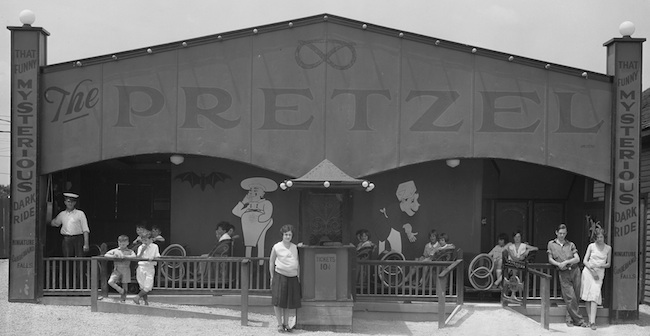
A Pretzel ride in 1930 at Joyland Park in Lexington, Kentucky, which closed down in 1964. (From the Lafayette Studio collection, courtesy of the University of Kentucky Special Collections)
They had a great success with this ride. Owners of other, non-competing amusement parks in the New Jersey area would come down to see it and ask Cassidy and Rempfer, “Can you guys build one of these for us?” The pair ended up going into business making dark rides. Calling their company the Pretzel Amusement Ride Company, they built a factory not too far from Tumbling Dam.
While Cassidy and Rempfer would patent certain things about their cars, their tracks, and some of their stunts, they couldn’t patent the dark ride itself. Other companies began to build dark rides, too, and they basically just called them Pretzel, because they didn’t know what else to call them. Park owners would put question marks on the doors, because what was behind them was supposed to be a mystery.
Collectors Weekly: And the earliest dark rides only had sound effects?

A plywood “Kicking Mule” stunt spooks little girls in Harry Traver’s Laff in the Dark, which operated at Kennywood amusement park in West Mifflin, Pennsylvania, from 1931 to 1965. (Courtesy of LaffintheDark.com)
LaCross: Yes. These rides were all in pitch darkness. Pretzel patented many of the first sound effects, which were actually floor devices. You’d go over a lever on the track, and it would strike acymbal, creating a sound like glass breaking. When the car would run over another lever, a container holding a bunch of ball bearings would get tipped up, and it’d sound like trash barrels tipping over. They had a string of bells hooked up, and they would just make a big clang when you went over that lever, which sounded like you were derailing.
Some of the earliest visual stunts they had — and some of them are still in operation — were motorless effects, lifted by the weight of the car. The sound effects weren’t necessarily right near these figures; those were usually positioned in the dark so you couldn’t see them. You’d be riding along in the Pretzel car in the dark, you’d hit a relay switch for the light, and then a lever for the figure itself. A small incandescent spotlight just focused on that black box would light up, and the cable would lift, say, a skull out of the bottom of the box.
For example, in the stunt called the “Jersey Devil,” you see what appears to be an empty box, and then the weight of the car forces a papier-mâché demon head to pop up inside it. For “Al E. Gator,” a lever on the track would tip a papier-mâché alligator on roller skates, and he’d lunge out at the riders. Some early stunts had limited gear motors, animating a head or hands going from side to side. Those would just go on, move for a few seconds, and then go back off again.
Collectors Weekly: How did dark rides evolve over the years?
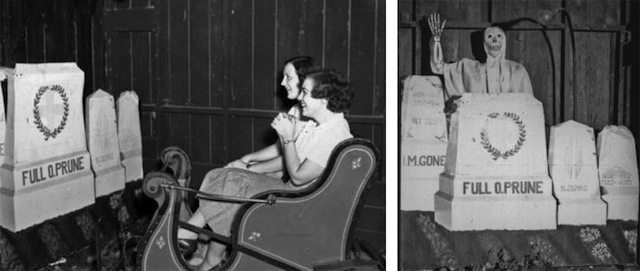
In 1934, photos of Laff in the Dark at Playland Park in Rye, New York, two women approach a cemetery scene where a skeleton pops up from behind a tombstone. (Courtesy of the Westchester County Archives)
LaCross: First, they started making magnetic switches that they could put in the track to trigger stunts, and these were less likely to break than the mechanical levers. The most recent triggers used in dark rides are photo sensors called electric eyes. Some are set off by the motion of the car, but some are even more sophisticated, using light from reflectors on the car so the stunts are set off at the exact right time.
For sound effects, Pretzel had the noisemakers, but then some companies started producing 78-speed records that were just recordings of screams. You got a whole stack of them, and when one was done playing, the record player would drop down another one, so that you heard continuous screaming. When theeight-track came out, dark rides switched to one-track cassettes called “sound repeaters.” It would just be a small amount of tape that played the sound of a ghost or whatever that would coincide with the stunt itself and then stop at a particular point. And it would automatically be rewound for the next car that came by. The problem with those cassettes is that, again, if you’re continually playing a tape, stop-and-go, stop-and-go, it breaks. Plus, the atmospheric temperature had to be right. If it got too hot, the playback machinery would go crazy and start playing the sounds at high speed. Since then, those tapes have been replaced with digital cards.
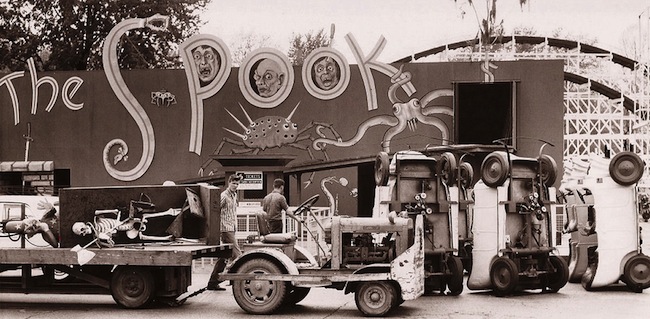
Workers install The Spook dark ride at a park called Coney Island in Cincinnati, Ohio, in 1960 for the 1961 season. (via CincinnatiViews.net)
Collectors Weekly: How did they use wind for effects?
LaCross: Wind and air have been used to good effect over the years. A 1960s tornado-themed ride in the Bronx’s Freedomland U.S.A. did quite a bit using big, industrial-strength fans. The final scene of the Riverboat dark ride at the park I grew up near — Crescent Park in Riverside, Rhode Island — was a hurricane simulation featuring a suspended A-frame house that you rolled underneath. That stunt had industrial-strength fans blowing in your face from all different directions. The house had pots and pans tacked up to its walls on fishing line, which would bang up against the oscillating A-frame. Now, some of the newer figures shoot compressed air out of their mouths to scare you. The newer figures from the modern stunt company Scare Factory often have that. A figure rises up out of a coffin, and it blows people’s hats right off their heads.
Collectors Weekly: How have the figures changed?
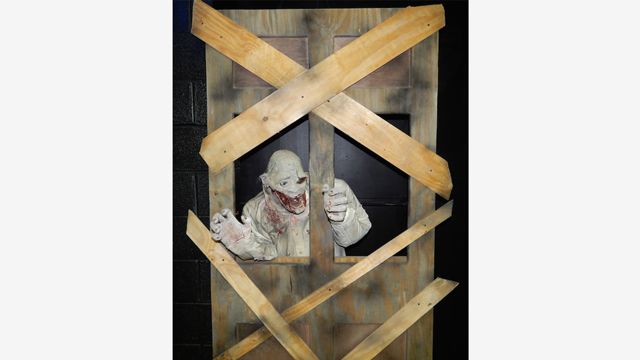
A ghoul that pops up inside a boarded door is one of the new Scare Factory stunts installed after 2012’s Superstorm Sandy hit Spook-A-Rama at Deno’s Wonder Wheel Park in Coney Island, New York. (Courtesy of LaffintheDark.com)
LaCross: The new figures are no longer made out of papier-mâché. They have metal frames with latex, and they’re not computerized. Disneyland and Disney World have the computerized animatronic figures, but most dark-ride stunts move through pneumatics. The figures contain air cylinders, and they have trunk lines going through them that connects to the ride’s one air compressor. These air cylinders just basically draw in a specific amount of air to animate them. It’s amazing what they can do with that. Some of them look quite real. You think they were computerized figures, but they’re not. They’re nowhere near as complicated as the computer-controlled Disney stuff.
Some dark rides still have their original papier-mâché stunts or the fibreglass stunts from afterWorld War II. The original stunts in Deno’s Wonder Wheel Park’s Spook-A-Rama in Coney Island, New York, got soaked with 6 feet of water by Superstorm Sandy last October. The park owners have been trying to restore those pieces, and they put some of those stunts back into the ride, because people like to see the old classics.
Collectors Weekly: How did the proliferation of television after World War II affect dark rides?
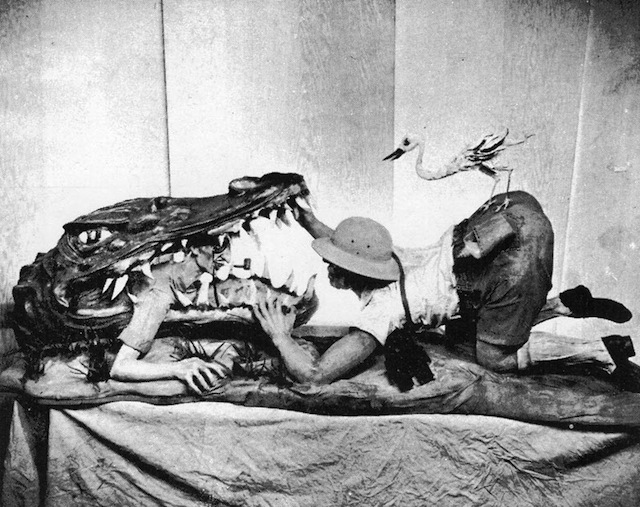
A “Stanley and Livingtone” stunt from a vintage Bill Tracy dark ride catalogue. (Courtesy of LaffintheDark.com)
LaCross: I think TV enhanced the popularity of dark rides. The Spook-A-Rama operators in Coney Island, New York, did their own version of some of the old Universal monsters like Frankenstein, the Wolfman, and the Mummy, in addition to what was originally installed. That’s because in the late 1950s Universal gave TV stations permission to start showing some of their monster movies from the 1930s and ’40s. And Bill Tracy’s stuff was often inspired by old movies featuring villains and damsels in distress and the like.
Dark rides would keep up with the times. When the horror film called “The Tingler” came out in 1959, the Coney Island ride operators built a creature like that movie’s monster themselves and advertised it would be inside Spook-A-Rama. Around 1968, when Adam West used to play Batmanin the campy TV series, the owner dressed up a male mannequin as Batman, and put him in the ride. Then he put a sign out that said, “See Batman!”
Collectors Weekly: Why don’t we see as many of these old dark rides today?
LaCross: There was one pivotal moment in 1984, when a walk-through dark attraction called Haunted Castle caught fire at the Six Flags Great Adventure in Jackson Township, New Jersey, and eight teenagers, who were trapped inside, died. Most parks had perfectly safe funhouses, walk-through scary houses, and single-rail dark rides, but after this fire, park owners grew so afraid of something happening. All kinds of new restrictions were put on these things; from then on, they always had to have sprinkler systems, smoke alarms, and emergency exits.
In the past, many dark rides did end up burning down because they didn’t have sprinkler systems. For the most part, the fire started at another attraction and just happened to sweep into them. Some dark rides did catch fire themselves. There was one situation where one of the ride operators tried to circumvent the fuse by putting a penny into it, and that caused the fire in the control panel and set a big blaze off.

LaffintheDark.com editor George LaCross (left) and creative director Bill Luca (right) with operator Stacy Vourderis and a couple of Bill Tracy stunts. Coney Island’s Spook-A-Rama used the Day-Glo figures, moved from New York’s shuttered Rockaway Park in the 80s, until Superstorm Sandy hit. (Courtesy of LaffintheDark.com)
But I don’t think the tragedy was reflective of most operating dark rides and funhouses in the 1980s. Yet a lot of parks did purge their rides shortly after. At this point, that tragedy seems pretty much forgotten. All of the operating dark rides that I know of have sprinkler systems, partially because these rides are so valuable now and they’re such attention-grabbers. Not only do the park owners want to protect their patrons in case a fire breaks out when the ride is operating, but they want to make sure that it’s protected when it’s not in operation, because the vintage ones can’t be replaced.
The older devices have been retrofitted with new insulated wiring and motors, which are pretty much fireproof. That doesn’t take away from the age and charm of the stunt. It does puts a little bit of a bogus slant on the ride when you see that emergency exit sign in the darkness. But they have to do it. You never can tell what might happen. If the rides didn’t have those, they wouldn’t be operating.
This article has been excerpted with permission from Collectors Weekly. To read in its entirety, head here.
